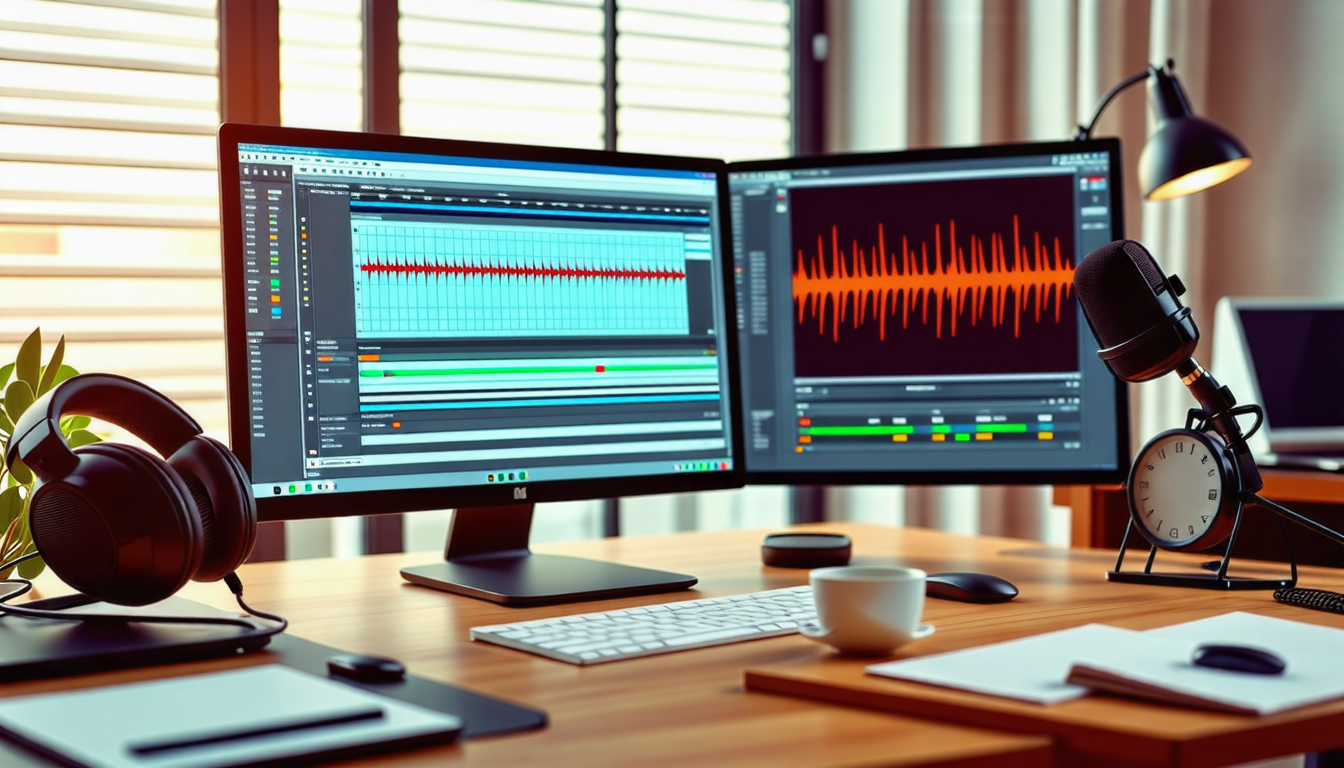|
IN BRIEF
|
Editing audio files quickly and efficiently requires a solid understanding of the tools and techniques available today. Whether you’re working with software like Audacity or Adobe Audition, the key to a streamlined process lies in establishing an organized workflow. Begin by carefully planning your edits, allowing you to navigate the audio file with ease. Utilizing keyboard shortcuts can significantly speed up the editing process, allowing you to focus on refining your sound rather than getting bogged down in repetitive tasks. Incorporating features like markers can help highlight important sections, making it easier to track your progress. By mastering these techniques, you will enhance your audio editing skills, leading to a more polished final product in a fraction of the time.

Editing audio files demands both speed and precision to ensure a polished final product. With the right tools and techniques, you can streamline your workflow, making the editing process less daunting. Understanding the nuances of your audio editing software and applying best practices can significantly enhance efficiency. Here are key strategies to expedite your audio editing tasks.
Choose the Right Software
Your choice of audio editing software greatly influences your editing speed and efficiency. Programs such as Audacity and Adobe Audition offer a user-friendly interface and a wide array of features that cater to both novices and professionals alike. When selecting software, consider factors like usability, speed, and functionality. For instance, if you’re just beginning, you might want to explore options such as EnergyXT which lists software suited for beginners. This can lead to a less overwhelming experience as you learn the ropes of audio editing.
Organize Your Audio Files
Efficiency in audio editing starts with organization. Before diving into the editing process, it’s essential to keep your audio files orderly. Create folders that categorize audio files based on projects, dates, or specific sessions. Labeling files descriptively allows for easy navigation when searching for particular clips. Furthermore, using features like tracks and regions in your editing software can help you manage multiple audio cues simultaneously, allowing for quicker access and editing.
Familiarize Yourself with Keyboard Shortcuts
One of the most effective ways to boost your editing speed is by utilizing keyboard shortcuts. Each audio editing software comes equipped with a range of shortcuts for commonly used actions such as cutting, pasting, and undoing edits. For example, mastering shortcuts like Ctrl+Z for undo or Cmd+Shift+I for importing audio on Mac can save a lot of time. Spend some time learning and practicing these shortcuts, as they will become second nature and greatly enhance your overall efficiency.
Implement a Dynamic Editing Approach
Dynamic editing techniques can streamline the process of creating audio content. Software such as Reaper allows for features like Dynamic Split, which can efficiently cut audio cues into individual segments. This feature can remove empty spaces automatically, leading to a more cohesive audio track without the tedious manual adjustments. Adopting such dynamic functionalities will aid in minimizing editing time while maintaining quality.
Use Markers and Labels for Easy Navigation
Markers and labels serve a critical role in enhancing workflow efficiency during audio editing. By placing markers at significant points in the audio, you can quickly jump to sections that require attention or adjustments. This method aids in tracking critical aspects of your audio recordings, ensuring that important segments are easily located amidst longer files. Proper usage of these tools can dramatically reduce the time spent searching for specific clips.
Plan Your Editing Process
Before beginning your editing process, it’s vital to have a clear plan in mind. Take the time to listen to the entire audio recording before implementing any changes. This preview will help you identify areas that need edits, including unnecessary segments, pauses, or awkward transitions. Planning out your edits allows for a more targeted approach, ensuring that you spend less time on trial and error.
Utilize Non-Destructive Editing Methods
Working with non-destructive audio editing software, like Audiate, allows you to make alterations without permanently affecting the original audio file. This flexibility means you can experiment with various edits and modifications while retaining the ability to revert back if needed. The ability to easily undo actions with commands like Ctrl+Z further contributes to a more efficient workflow, alleviating the anxiety that accompanies the editing process.
Optimize Your Working Environment
Creating an optimal working environment can significantly enhance your editing speed. Ensure that your workspace is comfortable, organized, and free from distractions. Consider investing in high-quality headphones to monitor audio accurately—good sound quality can prevent back-and-forth revisions. Additionally, using a dual-monitor setup can enhance workflow by providing ample screen space for viewing the editing software and reference materials simultaneously.
Take Advantage of Batch Processing
Batch processing features save significant amounts of time when handling multiple audio files. Many audio editing programs provide the option to apply the same edits across several files or to export them in batches. This functionality is particularly beneficial when working on projects that require consistent editing styles for a large number of recordings, as it eliminates the need to repeat efforts for each individual file.
Maintain an Organized Track Layout
When working with multiple audio tracks, keeping your track layout organized is vital. Clearly label each track with descriptive titles that reflect their content, such as “Dialogue,” “Background Music,” or “Sound Effects.” Using color coding for tracks can further enhance visibility, allowing you to navigate your project quickly and efficiently. This organization directly translates into a smoother editing process and helps minimize mistakes during editing.
Embrace Destructive Edits When Necessary
While non-destructive editing is often preferred, there are instances where destructive edits can save time. This approach can be suitable for less complex projects where you know the edits will not need to be undone. Committing to these edits can streamline finalizing a project, especially when clarity of the final product is paramount. However, weigh this decision carefully, as irreversible changes might not always be ideal.
Leverage Automation Features
Many audio editing software programs include automation features that can help streamline your workflow. For instance, using automation to adjust volume levels or panning can save you from manually mixing tracks bit by bit. This not only saves time but also can lead to a more polished sound due to the software’s ability to execute these adjustments accurately and consistently.
Seek Out Tutorials and Online Resources
With countless online resources available, leveraging video tutorials and forums can significantly enhance your editing skills. Websites and platforms often offer insightful tutorials specific to various audio editing software. Take advantage of these resources to learn about shortcuts, hidden features, and advanced editing techniques that can help speed up your workflow.
Regularly Save Your Work
In the realm of audio editing, accidents happen. Files get corrupted, software crashes, and unintentional edits occur. To mitigate the risks associated with these challenges, develop a habit of saving your work frequently. Set auto-save features if available, or establish a routine to save at predetermined intervals. This simple practice can save hours of potentially lost work and greatly reduce stress during the editing process.
Consider Using Templates for Consistency
If you frequently work on similar types of audio projects, consider creating audio templates. Templates allow you to pre-set your preferred effects, track layouts, and settings tailored to the needs of those specific projects. This can drastically reduce setup time, allowing you to dive straight into the editing process with a consistent and efficient workflow.
Incorporate Feedback Loops
Incorporating feedback into your audio editing process can help highlight areas for improvement, thus refining your efficiency. Share your edits with colleagues or peers for their input on clarity and quality. Understanding how your audience perceives your audio helps in making informed edits quickly, ultimately leading to a more refined finished product. Utilize this feedback cycle as a method of continuous learning and enhancement in your audio editing skills.
Stay Updated with Software Developments
Audio editing software is constantly being updated to incorporate new features and enhancements. Staying informed about the latest updates can provide you with tools that could simplify and expedite your editing process. Regularly check for updates from your preferred software providers, as new functionalities may lead to improved efficiency and streamlined editing workflows.
Implementing these strategies will greatly assist you in editing audio files quickly and efficiently. By understanding your software, organizing your projects, and adopting best practices, you’ll find that the editing process becomes a smoother and more productive part of your audio production journey.

Editing audio files quickly and efficiently requires a combination of the right tools, techniques, and strategies. Start by planning your project: listening to the entire audio before making edits can help identify critical segments. Utilize efficient software like Audacity or Adobe Audition, which offer powerful editing tools and features. Make use of keyboard shortcuts for faster navigation and editing processes. Organizing your audio tracks with markers and labels enhances workflow by making it easier to locate important sections. For longer projects, consider non-destructive editing programs that allow for easy adjustments without permanent changes. These strategies combined can significantly synchronize your editing workflow, saving you both time and effort while achieving a polished audio finish.
FAQ: How to Edit Audio Files Quickly and Efficiently
Q: What is the best way to start editing audio files efficiently?
A: Begin by planning your editing process. Listening to your audio file fully before starting any edits will provide you with a clear idea of what needs to be done.
Q: Which software is recommended for quick audio editing?
A: Popular options for efficient audio editing include Audacity, Adobe Audition, and Reaper. These software programs offer various tools to streamline your workflow.
Q: How can I reduce the time spent on audio editing?
A: Use keyboard shortcuts to navigate and edit quickly, and organize your tracks with markers and labels to identify key sections easily.
Q: Is there a way to visually cut audio cues separately?
A: Yes, software like Reaper allows you to use the Dynamic Split feature, which facilitates the quick separation of audio cues while removing empty spaces.
Q: How can I undo mistakes during audio editing?
A: In most audio editing software, you can easily undo your last actions by pressing Ctrl+Z or selecting the undo option from the Edit menu.
Q: What essential equipment is needed for sound editing?
A: A simple home recording setup typically requires a quality microphone, headphones, and a computer with reliable audio editing software.
Q: Can I edit long audio files more quickly?
A: Yes, you can utilize non-destructive editing features in software such as Audiate, allowing you to adjust and revise without permanently altering your audio files.
Q: How long does it typically take to edit one hour of audio?
A: The time required can vary, but efficient workflows, organized tracks, and familiarity with your software can significantly reduce editing time.

